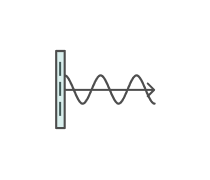Which of the following correctly represents distance and time?
How are your exam scores related to your study time?
Which of the following is a unit of area?
Which of the following is the reciprocal of a billion?
If two waves exist at the same location with the peaks and troughs in...
As sound travels through the body, what happens to the intensity of...
Which of the following units is associated with Duty Factor?
What is the characteristic of acoustic waves with frequencies less...
Which of the following units is associated with Pulse Repetition...
Two waves arrive at the same location and interfere with each...
Based upon the formula, PRP = 1/PRF, if the PRF increases, what...
When a sonographer changes the transducer, the system is now changed...
The X axis on a graph runs up and down or vertical.
Which of the following units is associated with Spatial Pulse...
The intensity of the beam is the same throught the beam.
What is the range of frequencies emitted by transducers used in...
Which of the following is the lowest intensity?
Wavelength is determined by:
What unit of measure is used for wavelength?
Which of the following units is associated with Pulse Repitition...
Path length does not affect attenuation.
Which of the following is a unit of volume?
Mathematically, when a number is squared, the number is multiplied by?
What are the units for intensity?
If the tissue does not change but the frequency of the transducer...
Sound travels fastest through tissue that is:
In the metric system, which one of the following prefixes matches the...
What is the wavelength of 2 MHz sound in soft tissue?
Which of the following units is associated with Pulse Duration?
When the sonographer changes the depth of view, which of the following...
If power is increased and the area is decreased, what happens to the...
Which of the following does not contribute to the attenuation process?
How are period and frequency related?
The thermal index is related to?
Which one of the following statements is correct?
If power remains the same and area is increased, what happens to the...
What is the highest intensity?
If the area of the beam increases, what happens to the intensity?
Which of the following is required for the answer to a numerical...
What determines the initial amplitude of a sound wave?
The intensity of an ultrasound beam is defined as the...
Based upon the SPL formula of SPL = c/f x # of cycles in the pulse, if...
Intensities are important in the study of?
If power is doubled, what happens to intensity?
Given that there are 2.54 cm in one inch. You measure the length...
Based upon the formula, DF = PD/PRP, if the PRP decreases, what...
Which intensity is important in the study of bioeffects?
Which of the following is the most sizable component of attenuation?
How many centimeters are there in 30 millimeters?
Two waves arrive at the same location and interfere with each...
What determines the period of an ultrasound wave?
Which of the following can the sonographer change? More than one...
Which of the following is the log of 10,000?
Which of the following represents the time form the start of one pulse...
By changing the depth of view, the sonographer can change the pulse...
Which of the following pulse reptition frequencies has the shortest...
Which of the following is correct?
If amplitude is doubled, what happens to intensity?
Which of the following represents the distance a pulse occupies in...
Which of the following pulse repetition frequency values would have...
What happens to the duty factor when the pulse repetition frequency...
Based upon the SPL formula of SPL = c/f x # of cycles in the pulse, if...
Which of the following pulsed wave parameters can the sonographer...
The sonographer changes the transducer from a 3 MHz to a 6 MHz...
Which of the following are the typical values for impedance?
What two factors must be present for refraction to occur?
You perform a Doppler study on a heart valve and find the velocity...
Which of the following cannot be considered a unit of frequency?
The original intensity is 2mW/cm squared. There is a change of...
The original intensity is 2 mW/cm squared. The signal has a...
Using the formula total attenuation (dB) = attenuation coefficient...
The speed of sound in soft tissue is all of the following EXCEPT:
Which of the following pulsed wave parameters can the sonographer...
What might the sonographer have done if the PRF increased?
Based upon the SPL formula of SPL = c/f x # of cycles in the pulse, if...
Currently, the AIUM states that no biologic effects are...
Using the formula Duty Factor - Pulse Duration / Pulse Repetition...
Whnat factors determine the propagation speed of sound? More...
Which of the following transducers would have the greatest depth...
If the frequency of a continuous wave transducer is 5 MHz,...
What is the intensity suggested by the AIUM for an unfocused beam?
Impedance is an important factor in determining.....
Which of the following is directly related to intensities?
Which of the following best describes the intensity of a CW beam?
The amplitude is measured from: More than one answer.
















